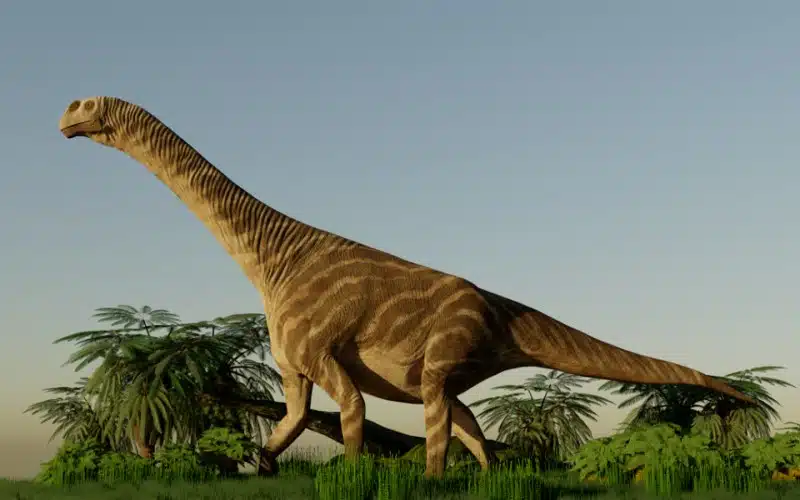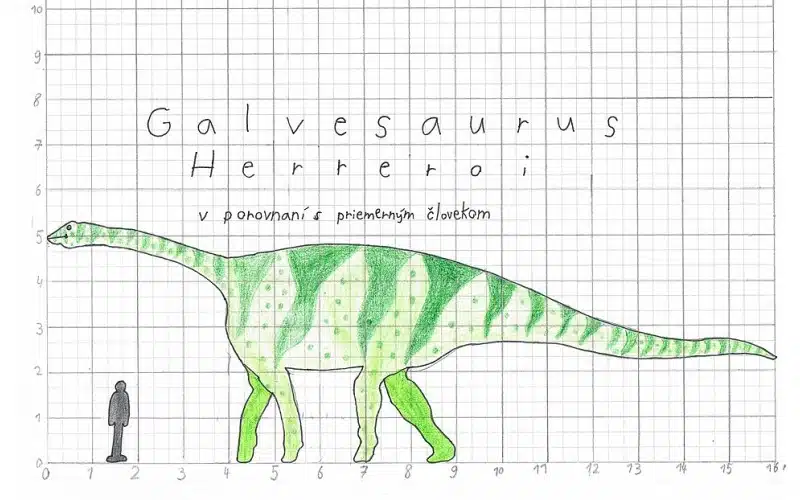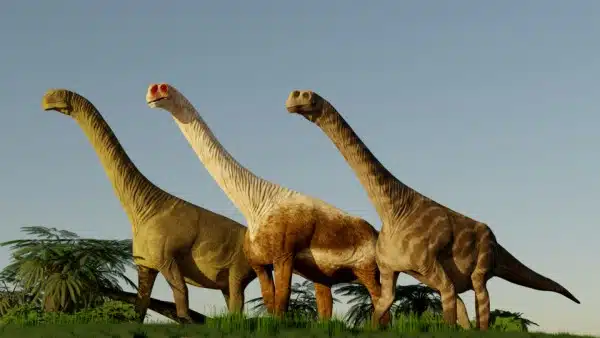Galvesaurus (or Galveosaurus, a synonymised taxon), a towering sauropod from the Late Jurassic, once roamed Spain’s lush Jurassic landscapes. As a brachiosaurid, this immense herbivore stood out for its long neck, strong limbs, and impressive size. Its discovery near the town of Galve in the Teruel Province has provided crucial insights into the rich diversity of dinosaurs that inhabited Europe during this time.
This dinosaur likely played a key role in shaping its environment, acting as both a consumer of plant life and a disperser of vegetation. Its presence alongside other dinosaurs of varying sizes and feeding strategies highlights the complexity of Jurassic ecosystems.
Galvesaurus Key Facts
| Keyword | Fact |
|---|---|
| Pronunciation | gal-VAY-oh-SORE-us |
| Meaning of name | Galve Lizard |
| Group | Sauropoda |
| Type Species | Galvesaurus herreroi |
| Diet | Herbivore |
| When it Lived | 155.7 to 145.0 MYA |
| Period | Late Jurassic |
| Epoch | Kimmeridgian to Tithonian |
| Length | 45.0 to 52.5 feet |
| Height | Approximately 13.0 feet at the hips |
| Weight | 2.0 to 2.5 tons |
| Mobility | Moved on four legs |
| First Discovery | 1980s by José María Herrero |
| Described by | 2005 by Jose Luis Barco, Jose Ignacio Canudo, Gloria Cuenca Bescós, and Jose Ignacio Ruíz Omeñaca |
| Holotype | MPG CLH 16 |
| Location of first find | Cuesta Lonsal Fossil site, Teruel, Spain |
Galvesaurus Origins, Taxonomy, and Timeline
The name Galvesaurus comes from the town of Galve, where its remains were first discovered. The second part of its name, sauros, comes from the Greek word for “lizard,” a common suffix in dinosaur nomenclature. This name not only highlights its geographic origins but also connects it to the many remarkable dinosaur discoveries made across the Iberian Peninsula.
Taxonomically, Galvesaurus belonged to the Sauropoda, the giant, long-necked herbivores that once dominated the prehistoric landscapes. More specifically, it was a member of the brachiosaurids (a group of titanosaur sauropods), sharing characteristics with the high-browsing, massive-bodied sauropods of North America and Africa. However, its taxonomic affiliation is regularly challenged, and the phylogenetic position of Galvesaurus regularly changes from one publication to another.

Galvesaurus lived during the Kimmeridgian and Tithonian (late Jurassic), a time when much of present-day Spain was covered in lush forests and winding floodplains. These environments provided an abundant supply of ferns, conifers, and cycads, essential for sustaining such a large herbivore. As the climate and geography of the region shifted, Galvesaurus and its contemporaries adapted, shaping the evolutionary course of sauropods in Europe and beyond.
Discovery & Fossil Evidence
The first fossils of Galvesaurus were unearthed in the 1980s near the town of Galve in the central part of the province of Teruel, North East of Spain, by local fossil hunter José María Herrero. These fossils were found within the Villar del Arzobispo Formation, a Late Jurassic sedimentary deposit known for preserving a variety of dinosaur remains. However, it was not until 2005 that the species was formally described by a team of paleontologists, including José Luis Barco, José Ignacio Canudo, Gloria Cuenca Bescós, and José Ignacio Ruíz Omeñaca. Another team concurrently described the same specimen in 2005 and named it Galveosaurus, which is now considered to be a synonym.
The holotype specimen, catalogued as MPG CLH 16, is a dorsal vertebra. The paratype (coming from the same specimen) consists of vertebrae, sacrum and limb bones. Although the remains are incomplete, the preserved vertebrae suggest a high-browsing lifestyle similar to other Brachiosaurids. The structure of its limb bones indicates it was a large, quadrupedal herbivore, adapted to moving through the dense forests that covered the Iberian Peninsula during the Late Jurassic.
Researchers have found additional fossil material in the same region that may belong to Galvesaurus, but they have not yet described a confirmed second specimen in detail. It includes fragments of the right coracoid and pubis.
Galvesaurus Size and Description
Galvesaurus was a large, quadrupedal sauropod with distinct adaptations that allowed it to feed on high vegetation. Its long neck, supported by thick, column-like legs, enabled it to browse treetops, while its tail acted as a counterbalance to its massive body. The broad-snouted, relatively small skull made it well-suited for stripping leaves from trees. Its longer forelimbs gave it a unique forward-sloping posture that helped it reach even higher branches.
Short Description of Galvesaurus
Galvesaurus was a high-browsing herbivore characterized by a long neck and a robust, quadrupedal body. Its vertebrae were air-filled, reducing the overall density of its frame while maintaining strength, allowing it to support its large size. The dinosaur’s tail was long and stiff, serving as a counterbalance to its body, enabling efficient movement despite its substantial weight. The skull has not been found, but related taxa suggest it had a relatively small skull and a broad snout, well-suited for stripping vegetation from branches—an essential adaptation for feeding in its forested environment.
An important feature of Galvesaurus was its posture, with longer forelimbs than hindlimbs, giving it a forward-sloping body alignment. This allowed it to efficiently reach and feed on treetops, an adaptation that set it apart from many other sauropods that had more horizontal postures. Its legs, thick and column-like, provided the stability needed to support its weight while moving through its habitat.
Size and Weight of Type Species
Galvesaurus herreroi is estimated to have measured between 45.0 feet and 52.5 feet in length, making it a moderately sized member of the Brachiosauridae family. With an approximate height of 13.0 feet at the hips, it was well-suited for high-browsing, much like its North American and African relatives, but smaller in comparison to the largest members of its group.

Weighing between 2.0 and 2.5 tons, Galvesaurus herreroi was lighter than many of its massive sauropod cousins, thanks to its air-filled vertebrae, which reduced its overall mass. This adaptation allowed it to maintain structural integrity without the need for a more massive, dense body. Despite its lighter weight, it retained the robust physical structure needed for a quadrupedal lifestyle, enabling it to support its long neck and reach for treetop foliage.
Though the fossil evidence remains limited, the available data, including comparisons with other Brachiosauridae, supports these size estimates. Galvesaurus herreroi was likely a moderately sized sauropod, ideally adapted to its high-browsing lifestyle in the lush, Late Jurassic forests of Spain.
The Dinosaur in Detail
Galvesaurus exhibited a fascinating combination of features that set it apart from other sauropods, making it well-adapted to its environment. Its most distinguishing trait was its long neck, which allowed it to reach the treetops in the dense forests of the Late Jurassic. This high-browsing adaptation is shared with other members of the Brachiosauridae, but Galvesaurus had unique characteristics, including its slightly forward-sloping posture due to longer forelimbs than hindlimbs. This posture enhanced its ability to access leaves from higher branches, making it a highly specialized herbivore for the forested environment of Iberia.
In addition to its specialized feeding capabilities, Galvesaurus possessed air-filled vertebrae that reduced its body mass without compromising strength, allowing it to maintain a lighter build compared to some of its larger relatives. This skeletal structure provided increased mobility and supported its massive neck, giving it a distinctive advantage in its habitat. The reduced weight also helped it avoid overburdening its limbs, which were sturdy and column-like, allowing the dinosaur to support its large body while moving through its environment.
The fossils discovered so far, including the holotype specimen, have provided valuable insights into the anatomy and lifestyle of Galvesaurus. While the fossil record is limited, the remains of Galvesaurus help us understand the evolutionary adaptations that occurred in the European sauropod lineage. The structural differences observed in its vertebrae, limbs, and neck provide crucial evidence of how these animals adapted to a high-browsing, forest-dwelling lifestyle. Though there are still gaps in our understanding, these early discoveries lay a foundation for further exploration into the lives of the fascinating dinosaurs that once roamed the Iberian Peninsula.
Interesting Points about Galvesaurus
- It belonged to the Brachiosauridae, meaning it was a relative of some of the tallest dinosaurs ever discovered.
- Its fossils were first found by an amateur fossil hunter, showing how significant contributions to paleontology can come from outside the scientific community.
Contemporary Dinosaurs
The Late Jurassic world of Galvesaurus was a vibrant and diverse ecosystem, home to a variety of dinosaurs, each fulfilling a unique role. Among them was Dacentrurus, a British stegosaur described by Sir Richard Owen, known for its large bony plates along its back and a fearsome spiked tail. Unlike the towering sauropods that browsed treetops, Dacentrurus remained close to the ground, feeding on low-lying vegetation and likely using its armor for protection from predators. Its specialized features allowed it to coexist peacefully with larger herbivores, avoiding competition by occupying a different niche in the ecosystem.

Lusotitan, a close relative of Galvesaurus, was another brachiosaurid that shared the same landscape. These two massive sauropods may have occupied overlapping territories. Potentially travelling in mixed herds or migrating seasonally in search of fresh vegetation. Their shared presence suggests that the ecosystem could support multiple high-browsing dinosaurs, with enough resources to sustain their large sizes and distinct feeding habits. The coexistence of Galvesaurus and Lusotitan highlights the dynamic nature of Late Jurassic herbivorous species and their ability to adapt to the changing environment.
The waterways of the region were ruled by Ophiussasuchus, a goniopholid crocodile. It posed little threat to fully grown Galvesaurus. However, it may have been a danger to younger sauropods and smaller dinosaurs that ventured too close to water sources. The need to drink could force these herbivores into risky encounters with predators, illustrating the constant tension between survival and danger in the Jurassic landscape. Despite the presence of such formidable predators, Galvesaurus and its contemporaries thrived in a rich, complex ecosystem where each species had its role to play.
Galvesaurus in its Natural Habitat
The Spanish Late Jurassic landscape was a rich and diverse environment. Dense coniferous forests blanketed much of the land providing ample food sources for herbivores like Galvesaurus. While coastal lowlands and floodplains offered open spaces for migration and seasonal changes. The climate was warm and humid, with seasonal shifts influencing the availability of plant life, which included cycads, ferns, and horsetails. These lush forests and varied environments made the region an ideal home for large herbivores. Seeing Galvesaurus thriving alongside other massive dinosaurs.
As a herbivore, Galvesaurus used its long neck to browse treetop vegetation, reaching food sources that were inaccessible to smaller dinosaurs. Its immense size protected him from most predators, although younger individuals may have been vulnerable to larger carnivores. The dinosaur’s slow, deliberate movements and sturdy limbs were well-suited for its grazing lifestyle, enabling it to consume large quantities of plants to support its massive body. Galvesaurus’s feeding behavior helped shape the forest structure by preventing any one type of vegetation from becoming overgrown, ensuring a diverse plant ecosystem.
Based on what we know about related sauropods it is likely it lived in herds. Herding would have offered protection against predators. It would also have increased foraging efficiency when traveling through the landscape in search of food. It is possible that these herds migrated seasonally, moving between areas of abundant food and water. This would have also allowed Galvesaurus to disperse seeds through its movement. Over time, these large herbivores, including Galvesaurus, contributed to the landscape by trampling vegetation, facilitating plant regrowth, and maintaining the balance of their ecosystems.
Frequently Asked Questions
Galvesaurus was a herbivore that fed on high-growing vegetation such as conifers, cycads, and ferns. Its long neck allowed it to reach leaves that other dinosaurs could not access.
Galvesaurus measured between 45.0 and 52.5 feet in length and stood approximately 13.0 feet tall at the hips. It weighed an estimated 2.0 to 2.5 tons.
As a large sauropod, it was likely safe from most predators. However, young or injured individuals may have been targeted by theropods or opportunistic scavengers.
While no direct evidence exists, it may have lived in herds, like many other sauropods. Herding behavior could have helped protect juveniles and improved access to food.
This dinosaur played a significant role in shaping its habitat. It was consuming large amounts of vegetation, dispersing seeds, and creating paths through dense forests. Its presence influenced the balance of the Late Jurassic ecosystem.
Sources
The information in this article is based on various sources, drawing on scientific research, fossil evidence, and expert analysis. The aim is to provide a comprehensive and accurate overview of Galvesaurus.
- https://www.researchgate.net/publication/235930354_On_the_phylogenetic_position_of_the_sauropod_Galvesaurus_and_other_reflections
- https://www.tandfonline.com/doi/full/10.1080/08912963.2016.1247447
- https://www.researchgate.net/publication/336137474_New_contributions_to_the_phylogenetic_position_of_the_sauropod_Galvesaurus_herreroi_from_the_late_Kimmeridgian-early_Tithonian_Jurassic_of_Teruel_Spain
Article last fact checked: Joey Arboleda, 03-01-2024
Featured Image Credit: Ferrutxo, CC BY-SA 4.0, via Wikimedia Commons
